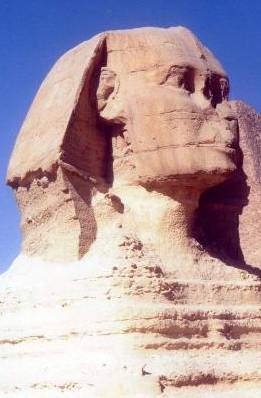

Baden's 1999 Mediterranean Tour - Egypt
If you have any comments on content, errors, or omissions, please mail me.
This travelogue is divided into several parts:
|
We landed among the desert sands and abandoned 707's at the Cairo Airport, and
the tarmac bus dropped us off at the terminal where I got in one of two long immigration lines that
were hardly moving. After an hour, when I neared the front, I asked an Australian standing next to
me in line about visas, and he said that I had to get the visa stamps at the little Thomas Cook bank
outside the customs hall, and sure enough, I did, but they were only US$15, less than half the cost
in Canada, and they were easy to get, so that's the way to do it, except to obtain them before you
get in line. ![]()
An airport taxi vendor sold me a limo ride to my Mövenpick Pyramids Resort for 75 L.E. (Libre Egyptian) or C$32, as I figured that the price was economical enough to avoid any hassles, and I arrived at the hotel in Giza after a long ride through Cairo, where the dirt and squalor were shocking. Most the buildings in Cairo were dirty and unfinished, but our excellent tour guide, Hesham, later explained that was since there were no rental properties or mortgages in Egypt, most people owned their buildings, and only built them as they could afford to. The dirt comes from the desert sand that blows in from the Sahara, and the desperately dry climate delivers no rain to clean the city.
 The Mövenpick
Resort was right beside the pyramids, which were way bigger than I ever thought, and lit up at
night, yielding an absolutely and uncompromisingly impressive sight. That Sunday afternoon, I went
out to buy some juice and coke, and I found a little sidewalk store just around the corner, where an
Egyptian intercepted me, and took me to his perfume store. It was somewhat neat, as it had all
natural essences from flowers, and I got away after a coffee and demonstration without too much
damage, as essences sold for L.E. 2 per gram, but he then took me over to his friend's store, where
I again had to buy some more stuff, but the reward was that the Egyptian souvenirs were all pretty
neat, which was more than I can say about most other places.
The Mövenpick
Resort was right beside the pyramids, which were way bigger than I ever thought, and lit up at
night, yielding an absolutely and uncompromisingly impressive sight. That Sunday afternoon, I went
out to buy some juice and coke, and I found a little sidewalk store just around the corner, where an
Egyptian intercepted me, and took me to his perfume store. It was somewhat neat, as it had all
natural essences from flowers, and I got away after a coffee and demonstration without too much
damage, as essences sold for L.E. 2 per gram, but he then took me over to his friend's store, where
I again had to buy some more stuff, but the reward was that the Egyptian souvenirs were all pretty
neat, which was more than I can say about most other places.
That night, after laying around the pool for the day, I ate supper with a British couple I met, who had just come back from the same tour route I was going on. They sounded a little disillusioned, and mentioned that the main problem was the Egyptian attitude towards chiseling on every deal, and nickel and dimeing, especially for Baksheesh, all the time. I figured that this was just the Arab disposition, which you just had to get accustomed to, as I was later reading a story about the same practices 150 years ago.
Later that night, my dad arrived from Canada through Paris, and we caught some sleep before an early start, initially off to visit the pyramids. The early start enabled me to get a ticket (from only 150 issued per day) to enter the Great Pyramid, Khufu (Cheops). I was the only one in our group who did, as it was supposed to be rather strenuous and enclosed. Even though I had to rush through, I was immensely impressed, as the scale and finish inside were awe inspiring, especially considering how big it was. I even laid in the sarcophagus in the King's tomb. The view down to the pyramid's base from the original real entrance was phenomenal, as I first thought that I was looking at reflections in a mirror, as it seemingly went down forever, but the passage was only accessible for a short length before a gate blocked it.
Next, we went around to the Khafre (Chephren)
Pyramid, and while the others visited the big sun boat, we looked at the huge pyramids. Khafre
had a skewed finish block at its top, and I noticed that Khufu was not geometrically perfect, but
that the pyramid twisted slightly from the base to the summit. This was interesting considering the
misconception that the pyramids were
geometrically perfect.
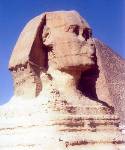 Afterwards, we went and visited the Sphinx, which
really amazed me as it was so diminutive, especially considering the large adjacent pyramids, as
photographs usually showed the Sphinx in the foreground appearing a lot bigger than it actually was.
Its head's preservation was quite remarkable though, and the Sphinx fit in well with the adjacent
pink granite (from Aswan) temple and the Khafre Pyramid, which were all supposed to have been
concurrently constructed about 3500 years ago.
Afterwards, we went and visited the Sphinx, which
really amazed me as it was so diminutive, especially considering the large adjacent pyramids, as
photographs usually showed the Sphinx in the foreground appearing a lot bigger than it actually was.
Its head's preservation was quite remarkable though, and the Sphinx fit in well with the adjacent
pink granite (from Aswan) temple and the Khafre Pyramid, which were all supposed to have been
concurrently constructed about 3500 years ago.
We then traveled into Cairo to visit the Muhammad Ali Mosque, which was constructed about 150 years ago, and was supposed to be the largest mosque in the world. The irony that an atheist was visiting so many Mediterranean religious sites did not escape me. After the bus stopped at some shops, we then visited the Cairo Museum for about 2.5 hours, which although antiquated, was jam packed with antiquities, more than any mortal could appreciate as a whole. Some objects' size and sculpture of were only surpassed by the detail and colours of others, including all King Tutankamen's tomb's contents.
The following morning, we had to get up very early to catch a flight to Aswan. The plane left at 5:00, and I had assumed that it would be a minor affair, but I was dead wrong, as it was a fully loaded Egypt Air 767. I was impressed with the Cairo Airport security, as they put everything through security, the x-ray guy was very competent, and they appeared to have the most sophisticated scanners and diligent checking for anywhere I had been. Considering the real security threat in that area, and the minimally intrusive professional check we went through, I would say that was about the best security I have seen. Anything in North America was only a facade, solely for placating nervous nellies.
The flight to Aswan took over an hour, which was also longer than I thought it
was going to be. From the impressive new Aswan terminal, we were bussed through the Sahara, across
the Aswan Dam, originally completed in 1902 by the British, and down through Aswan to our boat, the
Nile Cruiser
H.S.Radamis, which was another Mövenpick Hotel. Our boat was one of dozens tied up along
the river. Our guide, Hesham, said that there were approximately 250 hotel boats, 50 being first
class. We were able to lay around on the deck in the sun for a few hours, before we went on a felucca (Egyptian sailboat) trip on the
Nile around Elephantine Island. The trip was
impressive, for not only was the scenery superb, but the trip was totally relaxing.
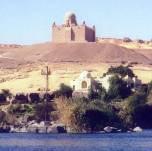 The neatest thing may have been the little boys who had tiny hand paddled boats in the huge Nile
River and went around trying to sell junk to the tourists, avoiding all the big ships in the
process. Our felucca was astoundingly maneuverable, so it could go through narrow twisting passages
as easily as a canoe. After a while, we were able to view the Aga Khan mausoleum and mansion on the
Nile west bank. Apparently, the Aga Khan enjoyed Aswan a lot, and lived there for a long time, even
though his followers were not near. After his death in 1957, he was buried in the huge mausoleum high up on the west bank. He was supposed
have been given for each significant birthday, an increasing quality of precious commodities equal
to his body mass, and as that was also increasing, the value got very high. Our felucca then easily
negotiated an extremely narrow and winding passage, and floated back down the river, past the hotel
where Agatha Christie wrote "Death on the Nile", to the dock near our cruise boat. After lunch, we
boarded a bus for a trip to the Unfinished
Obelisk, which was more or less right in Aswan. The obelisk was in an ancient quarry that
looked as if it were just worked yesterday due to the granite's hardness, but was actually 3500
years old. It was extremely interesting to see how the Egyptians broke granite apart by first
notching the rock, and then wetting wooden wedges inserted in the rock to cleave it. The Unfinished
Obelisk would have been the biggest obelisk in the world, however, it cracked in two places before
it was extracted, so it was abandoned, along with the quarry, which was deemed to have unsuitable
rock. After, we drove over the Aswan Dam to the Aswan High Dam, which was built by the Russians over
30 years ago, creating Lake Nassar, flooding a lot of land and ruins, right into the Sudan.
The neatest thing may have been the little boys who had tiny hand paddled boats in the huge Nile
River and went around trying to sell junk to the tourists, avoiding all the big ships in the
process. Our felucca was astoundingly maneuverable, so it could go through narrow twisting passages
as easily as a canoe. After a while, we were able to view the Aga Khan mausoleum and mansion on the
Nile west bank. Apparently, the Aga Khan enjoyed Aswan a lot, and lived there for a long time, even
though his followers were not near. After his death in 1957, he was buried in the huge mausoleum high up on the west bank. He was supposed
have been given for each significant birthday, an increasing quality of precious commodities equal
to his body mass, and as that was also increasing, the value got very high. Our felucca then easily
negotiated an extremely narrow and winding passage, and floated back down the river, past the hotel
where Agatha Christie wrote "Death on the Nile", to the dock near our cruise boat. After lunch, we
boarded a bus for a trip to the Unfinished
Obelisk, which was more or less right in Aswan. The obelisk was in an ancient quarry that
looked as if it were just worked yesterday due to the granite's hardness, but was actually 3500
years old. It was extremely interesting to see how the Egyptians broke granite apart by first
notching the rock, and then wetting wooden wedges inserted in the rock to cleave it. The Unfinished
Obelisk would have been the biggest obelisk in the world, however, it cracked in two places before
it was extracted, so it was abandoned, along with the quarry, which was deemed to have unsuitable
rock. After, we drove over the Aswan Dam to the Aswan High Dam, which was built by the Russians over
30 years ago, creating Lake Nassar, flooding a lot of land and ruins, right into the Sudan.
On the return over the dam, we could see ruins across the lake to where we were heading. The Temple of Isis, or Philae Temple was situated on a neat little island, and was totally relocated there in 1974, as the original and lower nearby site on Philae Island was inundated most the year, due to the reservoir behind the dam. Our bus drove over to a dock, and then we took a little launch over to the island, which was just big enough to hold the temple. The temple, along with almost all the other temples and monuments we saw, was heavily defaced by the christians. The christian artifacts that I had seen destroyed or defaced were insignificant compared to the massive destruction in Egypt. The effort required to deface all the exquisite works must have been a extensive undertaking in itself. The temple had an auxiliary small temple beside it, and from there, we could see coffer dam remnants from the old island, Philae, which was constructed when they relocated the temple to the new island.
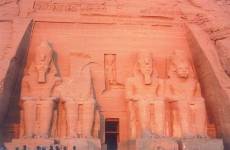 We returned to the cruise boat to eat some more excellent food, and I later tried using an internet
cafe in Aswan, where I met a former UBC classmate, but the connection was so terrible, that I could
not even get my pine up after an hour. We went to sleep early, as we had to get up at 3:30 to go
and visit Abu Simbel, which was way up Nassar
Lake, and required about an hour flight. I once again assumed that there would be a little plane to
take us there, but when we arrived at the airport for our 6:00 flight, there were five airlines all
flying jets to the Abu Simbel airport. Our 737 jet held almost all French people, who had the odd
custom of all clapping when we landed. As with almost all the other places we visited, the tourists
all numbered in the thousands. Considering that it cost us each US$200 to go to Abu Simbel, you can
imagine the benefit to the Egyptian Economy that tourism provided. It was ironic that there was a
road that busses used to drive on, but after it was rebuilt several years ago, the airlines
persuaded the government to leave the road closed. The airport at Abu Simbel was almost as nice as
the one at Aswan, but smaller, and as a special bonus there were hungry dogs waiting for us on the
runway to receive our extra lunches. They were very tame, and seemed to know where and when to get
fed.
We returned to the cruise boat to eat some more excellent food, and I later tried using an internet
cafe in Aswan, where I met a former UBC classmate, but the connection was so terrible, that I could
not even get my pine up after an hour. We went to sleep early, as we had to get up at 3:30 to go
and visit Abu Simbel, which was way up Nassar
Lake, and required about an hour flight. I once again assumed that there would be a little plane to
take us there, but when we arrived at the airport for our 6:00 flight, there were five airlines all
flying jets to the Abu Simbel airport. Our 737 jet held almost all French people, who had the odd
custom of all clapping when we landed. As with almost all the other places we visited, the tourists
all numbered in the thousands. Considering that it cost us each US$200 to go to Abu Simbel, you can
imagine the benefit to the Egyptian Economy that tourism provided. It was ironic that there was a
road that busses used to drive on, but after it was rebuilt several years ago, the airlines
persuaded the government to leave the road closed. The airport at Abu Simbel was almost as nice as
the one at Aswan, but smaller, and as a special bonus there were hungry dogs waiting for us on the
runway to receive our extra lunches. They were very tame, and seemed to know where and when to get
fed. ![]() We arrived at the temple before dawn, so I was able to obtain a photo just as the sun's first
rays struck the monument. Abu Simbel was an imposingly large temple constructed on the Nile's west
bank by Ramses II, 3300 years ago. In the temple's inner recess, was a shrine which had the same
figures as the front on a much smaller scale. On either side of Ramses II were gods, and on the far
left was the god of darkness, Ptah. On only two days a year, the sun shone straight through the
front door 56 m to the temple rear, and lit up the shrine, but only on three figures, missing Ptah.
The wild thing was that the two days coincided with Ramses II birthday and his coronation day.
We arrived at the temple before dawn, so I was able to obtain a photo just as the sun's first
rays struck the monument. Abu Simbel was an imposingly large temple constructed on the Nile's west
bank by Ramses II, 3300 years ago. In the temple's inner recess, was a shrine which had the same
figures as the front on a much smaller scale. On either side of Ramses II were gods, and on the far
left was the god of darkness, Ptah. On only two days a year, the sun shone straight through the
front door 56 m to the temple rear, and lit up the shrine, but only on three figures, missing Ptah.
The wild thing was that the two days coincided with Ramses II birthday and his coronation day.
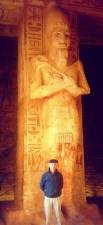 The whole Abu Simbel site was moved between 1964 and 1966 to a location higher on the river bank, as
the new Lake Nassar reservoir behind the Aswan High
Dam would have flooded it. It displayed how advanced ancient Egyptian astronomy and
construction were, for when the temple was relocated, modern engineers were unable to exactly
replicate the original position, so now the sun shines on the shrine a day out. The original temple
complex was carved from the sandstone river bank, and it consisted of the main temple for Ramses II, and a smaller one for his wife,
Nefertari. The temple was rediscovered in 1813, and since then, the colours had significantly
faded, but the queen's temple, though smaller, appeared to be finer constructed and better
preserved. After visiting both temples, we went through a doorway and met a big surprise, as the
relocated temples were all just a facade, under huge concrete domes supporting artificial hills
encompassing the temples.
The whole Abu Simbel site was moved between 1964 and 1966 to a location higher on the river bank, as
the new Lake Nassar reservoir behind the Aswan High
Dam would have flooded it. It displayed how advanced ancient Egyptian astronomy and
construction were, for when the temple was relocated, modern engineers were unable to exactly
replicate the original position, so now the sun shines on the shrine a day out. The original temple
complex was carved from the sandstone river bank, and it consisted of the main temple for Ramses II, and a smaller one for his wife,
Nefertari. The temple was rediscovered in 1813, and since then, the colours had significantly
faded, but the queen's temple, though smaller, appeared to be finer constructed and better
preserved. After visiting both temples, we went through a doorway and met a big surprise, as the
relocated temples were all just a facade, under huge concrete domes supporting artificial hills
encompassing the temples.
After we returned from Abu Simbel about noon and had lunch, our cruise boat started down the Nile. The vista and experience were very pleasurable, and I would not mind travelling down the whole river like that. It was very interesting to be on the river, surrounded by lush irrigated land in the middle of the Sahara desert. Just before sunset, we docked by the east bank at Kom Ombo, where there was a big temple beside a bend in the river. There were the usual kids trying to sell stuff, along with different vendors on the way to the temple, as well a snake charmer with his cobra. The temple was interesting, as it was actually two duplicate adjoining temples in one. It was more or less destroyed, but what was left was still impressive. One room had been discovered with about 200 mummified crocodiles in it, and two were still on display. Apparently, the crocodiles frequented that spot in the river, and were considered a god by the local inhabitants.
 After dusk, we sailed down the river some more to Edfu, where we tied up for the
night. In the morning, horse carriages took us over to the Edfu Temple, which was supposed to be the best
preserved of all the Egyptian temples. It was an incredibly awesome sight, as it was so massive and
so well decorated. When we arrived, there were some goats playing on the nearby ruins, but the
guards chased them away. Again, the sad thing was to see all the defilement by the christians, as
they must have spent uncountable man-years to deface all the reliefs the way they did.
After dusk, we sailed down the river some more to Edfu, where we tied up for the
night. In the morning, horse carriages took us over to the Edfu Temple, which was supposed to be the best
preserved of all the Egyptian temples. It was an incredibly awesome sight, as it was so massive and
so well decorated. When we arrived, there were some goats playing on the nearby ruins, but the
guards chased them away. Again, the sad thing was to see all the defilement by the christians, as
they must have spent uncountable man-years to deface all the reliefs the way they did.
After noon, we departed down the river once again to Esna, which was our boat's terminus, rather than the usual Luxor, as the locks at Esna were closed for the annual two week maintenance period for the downstream canals, so do not plan a Nile cruise for the first two weeks in December. There were actually two barrages across the river, an old one, and a new one. In the afternoon, we took short walk over to the local temple. Even though it had only been partially excavated, it was still impressive. Only the top bit was previously above ground, before a large pit was dug around it, so the interior colours were better preserved than normal. In the last century, when the British and French were fighting, the French were holed up inside, and there were quite a few bullet holes girdling the roof from that battle.
The following day was planned to be the mother tour of all tours. Not only were we to take the bus to see the Valley of the Queens and the Valley of the Kings on the west bank, which would be a full day all by itself, but we were also scheduled to visit Karnak and Luxor temples, which were each massive sites. Needless to say, some crew were mutinous, but it was not possible to change the itinerary, because a bus was not available the following day.
We took the bus over the new barrage, which was downstream from the old one, and drove about an hour down along the Nile's east bank towards Luxor, then crossed a relatively new bridge across the river again, over to the Valley of the Queens. The valley faced east toward the Nile, and was more like a dry gulch in the plateau. The tombs were all totally hidden and discovered only relatively recently, and it was only in modern times that archeologists built portals to enter the tombs. We visited a prince's tomb, and two queens'. Princes were also buried in the Valley of the Queens, as only kings were buried in the Valley of the Kings. To take photographs inside the tombs, it was necessary to purchase a special ticket. I did not realise that a different ticket was needed for each tomb, and I got hell in the second one. It was difficult to take photographs, as flashes were not allowed, so each one had to be time delayed, while trying to hold the camera still and focus through glass. The end result was next to terrible, and it would have been much better to just buy postcards, or better yet, the excellent books from the Italian publisher, Bonechi, specifically this one.
From the Valley of the Queens, we drove a short distance over to an alabaster factory and shop, where they demonstrated making alabaster bowls. They had machine made and hand made artifacts for sale, but the hand made ones were much finer and thinner, and also much more expensive. I was always totally intrigued by alabaster, especially statues, so I did buy a nice (machine made) bowl.
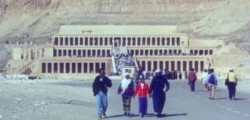 After that, we drove over a short distance to Queen
Hatshepsut's Temple, which looked extremely impressive, as it was carved from a massive
sandstone cliff, and had columns all along its three stories. The depth was very narrow, only a few
metres in most places. The colours had been well preserved, which may have been due to most the
temple being buried by desert sand for most its existence. That was one concern I had, since most
these antiquities and ancient sites were ignored and buried for so long, that they must be
deteriorating much faster now that they were on display. I guess they would just be another victim
of 'progress'. Hatshepsut's Temple was significant, for in November 1997, five terrorists rode
donkeys over the mountain range behind the temple, and down into the valley. No one really noticed
them, as that was a common donkey trail for tourists to visit the Valley of the Kings, and they all
wore the Arab robes, which hid their weapons. They went up onto the second level on the right, and
proceeded to shoot and kill about 80 German and Swiss tourists. In the chaos, the police took about
1.5 hours to arrive, and the terrorists escaped. They figure that incident cost the Egyptian
economy over one billion dollars in lost tourist revenue, and the security was subsequently much
tighter. Surrounding all the monuments were Egyptian army pill boxes and armed troops. The
security was actually fairly unobtrusive, and I thought it was very good.
After that, we drove over a short distance to Queen
Hatshepsut's Temple, which looked extremely impressive, as it was carved from a massive
sandstone cliff, and had columns all along its three stories. The depth was very narrow, only a few
metres in most places. The colours had been well preserved, which may have been due to most the
temple being buried by desert sand for most its existence. That was one concern I had, since most
these antiquities and ancient sites were ignored and buried for so long, that they must be
deteriorating much faster now that they were on display. I guess they would just be another victim
of 'progress'. Hatshepsut's Temple was significant, for in November 1997, five terrorists rode
donkeys over the mountain range behind the temple, and down into the valley. No one really noticed
them, as that was a common donkey trail for tourists to visit the Valley of the Kings, and they all
wore the Arab robes, which hid their weapons. They went up onto the second level on the right, and
proceeded to shoot and kill about 80 German and Swiss tourists. In the chaos, the police took about
1.5 hours to arrive, and the terrorists escaped. They figure that incident cost the Egyptian
economy over one billion dollars in lost tourist revenue, and the security was subsequently much
tighter. Surrounding all the monuments were Egyptian army pill boxes and armed troops. The
security was actually fairly unobtrusive, and I thought it was very good.
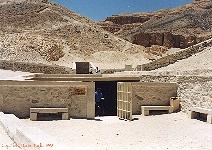 After the tomb, we drove north around a hill, and proceeded up a narrow valley which ended up at the
Valley of the Kings. It more or less reminded
me of some dry gulch valleys in the western United States, as there was no vegetation at all. While
the valley had about 80 tombs, only several were open to public view at any one time, to enable the
others to recuperate from human intrusions. We visited three tombs, including an unfinished one,
Seti II, which was interesting as it showed the tomb construction methodology. After the kings
died, the workers only had 117 days to complete the tomb before it was permanently sealed, so I
guess the contractor failed to receive his completion bonus for that one. The sandstone chambers
were first excavated, then the wall reliefs were carved into the rock. Afterward, a plaster
coasting was applied to all the walls, and the reliefs were redrawn with pencil, re-carved with a
final, finer detail, and then redrawn again to facilitate their painting. All the interiors were
vividly painted, and it astounded me that the bright colours would remain intact for so many
thousand years.
After the tomb, we drove north around a hill, and proceeded up a narrow valley which ended up at the
Valley of the Kings. It more or less reminded
me of some dry gulch valleys in the western United States, as there was no vegetation at all. While
the valley had about 80 tombs, only several were open to public view at any one time, to enable the
others to recuperate from human intrusions. We visited three tombs, including an unfinished one,
Seti II, which was interesting as it showed the tomb construction methodology. After the kings
died, the workers only had 117 days to complete the tomb before it was permanently sealed, so I
guess the contractor failed to receive his completion bonus for that one. The sandstone chambers
were first excavated, then the wall reliefs were carved into the rock. Afterward, a plaster
coasting was applied to all the walls, and the reliefs were redrawn with pencil, re-carved with a
final, finer detail, and then redrawn again to facilitate their painting. All the interiors were
vividly painted, and it astounded me that the bright colours would remain intact for so many
thousand years.
We also went way down into Amenhotep II's tomb, which was the most impressive. A long corridor led down to two false chambers, designed to thwart tomb robbers, and then entered the massive burial chamber itself. In the first chamber, I was extremely impressed with the ceiling colour and detail, so although I did not have a photo permit for the tomb, I first looked around and after not seeing any typical Egyptian guards in their robes, I took a timed shot as best I could. I was walking away when I heard a voice behind me in several different languages, until he was right beside me. Rather than a guard in robes, he had a brown suit on, along with his AK-47. He asked me for my permit, and I pleaded stupidity, so he gave me shit for taking the picture, even though it was ridiculous that they try to nickel and dime tourists who had spent thousands to be there. I did not get any quality photographs from inside the tombs, so my advice is forget the cameras, unless you have a tripod. By far the best route was to purchase the beautiful books on Egypt, which came in several languages with fantastic photos and accompanying explanations.
After exiting the tomb, and leaving the valley, we went back to stop at the Memnon Temple ruins before returning across the river to visit the Karnak Temple in Luxor. The Memnon Temple was destroyed in antiquity by a large earthquake, and all that remained were two large statues that were once originally solid rock. At Karnak, as everywhere we went, massive crowds in the thousands also were visiting the temple. Although the temple's exterior was not that impressive, the interior was phenomenal, even though the preservation was not as good as in some other temples. The site was vast, but most the back half was deserted more than other sites. One interesting thing was that a large earthen ramp remained on one wall, so that ancient wall construction techniques were still apparent. There were two big obelisks remaining in the temple, apparently the largest in the world. One other obelisk was toppled by a jealous king in antiquity, and another was confiscated and taken to France by Napoleon. Also, in relatively fine shape, was a colossal entrance hall with enormous columns supporting an intact roof. All I could imagine was that at one time the site must have been more than mind boggling, and must have been one of the world's wonders.
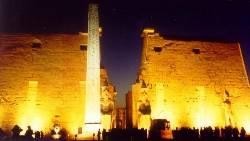 After our excursion through the Karnak temple, we took the bus to the Luxor Temple, which was about 2.5 km directly south.
The two temples were joined by the Avenue of the
Sphinxes, which was a wide avenue, totally lined on both sides along the entire length with
similar sphinx statues all about 4 m tall. Only portions were excavated, as most the avenue was
covered by the modern city. We arrived at the Luxor temple shortly before sunset after a long and
exhausting day, so I was able to get photographs in the twilight. While the Luxor temple was not as
grand and as extensive as Karnak, its preservation was much better, and the statues, art, and
architecture were all immense and incredibly impressive. In one interior corner, written on the
wall in hieroglyphics, was the story of Moses and his trip to Egypt. The interior courtyard was
surrounded by massive statues that must have been all that more impressive when they were all
painted.
After our excursion through the Karnak temple, we took the bus to the Luxor Temple, which was about 2.5 km directly south.
The two temples were joined by the Avenue of the
Sphinxes, which was a wide avenue, totally lined on both sides along the entire length with
similar sphinx statues all about 4 m tall. Only portions were excavated, as most the avenue was
covered by the modern city. We arrived at the Luxor temple shortly before sunset after a long and
exhausting day, so I was able to get photographs in the twilight. While the Luxor temple was not as
grand and as extensive as Karnak, its preservation was much better, and the statues, art, and
architecture were all immense and incredibly impressive. In one interior corner, written on the
wall in hieroglyphics, was the story of Moses and his trip to Egypt. The interior courtyard was
surrounded by massive statues that must have been all that more impressive when they were all
painted.
After night fell, we were able to leave Luxor for the one hour drive back to our boat in Esna, and I have to state that it had to be the most phenomenal tour day in my whole life, which I don't ever expect to repeat. When I return one day, I surely will take at least a week to view what we completed that day.
The next day we had a leisurely schedule, and we boarded a bus after noon for our trip to Luxor Airport for the departure to Cairo. The first bus broke down, and never reached us, and the second bus managed to have fuel problems on the way, and finally broke down just inside Luxor. After waiting for a mechanic to repair it, we did get back to the airport for our 767 Egypt Air flight to Cairo, where we arrived late. We had a dinner and show cruise on the Nile river planned, but we just missed the boat, so little boats were used to ferry us out to the excursion boat. The entertainment (belly dancing and band) and food were fine, but the whole atmosphere was poisoned by excessive tobacco smoke, which made remaining inside almost intolerable. We sometimes don't appreciate the fine air we can dine with in Vancouver.
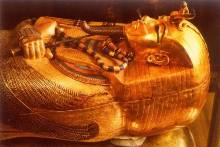 After a late arrival at the hotel, we went to bed right away, as my dad had to wake up at 5:00 for
an early morning departure through France back to Canada. I was able to wake up leisurely, and then
leave at noon to go visit the Egyptian
Museum again for the day. I figure that the taxi driver must have been really hungry, as he
made an appointment with me for the ride after to the airport. The museum was much easier to visit,
when I didn't have to rush through, and I was also able to revisit several exhibits that I did not
have time to fully appreciate the week before. My only complaint was that most the displays in the
museum had an excessive amount of exhibits, which tended to trivialise individual exhibit's
importance.
After a late arrival at the hotel, we went to bed right away, as my dad had to wake up at 5:00 for
an early morning departure through France back to Canada. I was able to wake up leisurely, and then
leave at noon to go visit the Egyptian
Museum again for the day. I figure that the taxi driver must have been really hungry, as he
made an appointment with me for the ride after to the airport. The museum was much easier to visit,
when I didn't have to rush through, and I was also able to revisit several exhibits that I did not
have time to fully appreciate the week before. My only complaint was that most the displays in the
museum had an excessive amount of exhibits, which tended to trivialise individual exhibit's
importance.
After the museum, I went to an internet store in the mall next to the Hilton, where the service and connection were not too bad, especially compared to Aswan. After that, I met my taxi driver, and he took me to the wrong airport, which cost too much to leave again (20 L. E.), and then over to the correct one, for the 22:30 El Al flight to Tel Aviv. I was fortunate enough again to have a complete search done by security, except they took everything apart right out in the check-in hall. They were totally paranoid about my Sharp organiser, and they were not even going to let me have it back, but ship it separately to Canada, however, after being segregated completely from the other passengers until the last departing passenger, I finally got it back.
Once again, totally due to superior security, I luckily managed to fly in an
airplane without being hijacked or blown up, and I arrived in Tel Aviv, with an hour to spare, but
the Monday morning 01:30 Air Canada flight back to Toronto was
overweight, so I could not get on. Short of being slightly panicked about the situation, as I had
to fly that Thursday morning from Vancouver to Mexico, I did get a room at the Bell Hotel on Allenby
Street near the water in Tel Aviv, which for only US$55, was the smallest room I ever rented in my
life. The next day, I went up to the Air Canada office to get
some encouragement about my chances to get back to Canada that night, and then I went for a long
walk down the beach and back. The beach was mostly deserted, as it was not that hot, but there were
signs either stating the beach was closed for swimming due to pollution, or for security reasons.
An interesting thing was that young soldiers on leave in civilian clothes were everywhere, all
carrying loaded automatic weapons. Later in the day, I walked along the same beach to Jaffa, and
looked for the military museum, to which I was directed to a rather decrepit neighbourhood. Jaffa
was restored, so it was slightly touristy, long on prices, but short on substance. When I did find
the museum, I found out that not only was everything only in Hebrew, but they would not take gringo
dollars for admission, so I decided that the experience would not be useful, and I returned back to
the hotel. I had previously withdrawn a whole bunch of shekels, and after leaving Israel, I thought
it would be easy to change to different currencies, but I was dead wrong, as everywhere I went,
nobody would touch shekels. So I did change them back at the Tel Aviv airport before I couldn't get
on the Monday flight,
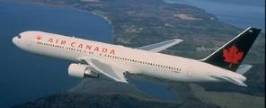 and then I was stuck with only gringo bucks for the next day. After a leisurely walk up and down
Allenby street, and later a leisurely supper, I missed the airport bus, so I took a taxi to airport,
where I was lucky to get on the 1999-12-07 01:30 767-300 flight to Montreal. The
plane was rather empty and relaxing, and after a perfunctory trip through Montreal customs, I was
able to get a direct Airbus 320 flight ninety minutes later to Vancouver for my 40 hour layover
before the JAL jet took me to Mexico, completing my
four continent tour.
and then I was stuck with only gringo bucks for the next day. After a leisurely walk up and down
Allenby street, and later a leisurely supper, I missed the airport bus, so I took a taxi to airport,
where I was lucky to get on the 1999-12-07 01:30 767-300 flight to Montreal. The
plane was rather empty and relaxing, and after a perfunctory trip through Montreal customs, I was
able to get a direct Airbus 320 flight ninety minutes later to Vancouver for my 40 hour layover
before the JAL jet took me to Mexico, completing my
four continent tour.